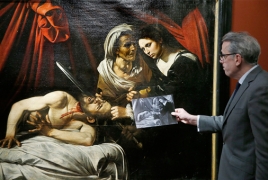
An original Caravaggio or a master fake? This is the question that continues to befuddle art historians and experts about a painting discovered in a French attic three years ago, AFP said.
The 400-year-old canvas -- depicting the beheading of an Assyrian general, Holofernes, by Judith from the biblical Book of Judith -- was found in 2014 when the owners of a house near the southwestern city of Toulouse were investigating a leak in the ceiling.
Discovered in remarkably good condition, the work was painted between 1600 and 1610, specialists believe, and could be worth as much as 120 million euros ($132 million).
But whether the spectacular large-format canvas is the long-lost masterpiece by Italian Renaissance master Michelangelo Merisi da Caravaggio or the work of Louis Finson, a Flemish painter and disciple of Caravaggio who died in 1617, has the art community divided.
Art historian Giovanni Agosti even resigned in protest over the issue when Milan's Brera Art Gallery, where he was a board member, decided last year to put the painting on display alongside authenticated works by the Renaissance master.
The disputed painting hung next to the authenticated copy of the same scene by Finson from around 1607.
The museum hedged its bets by including an asterisk on its caption attributing the work to Caravaggio but referring viewers to notes on its history in the exhibition catalogue, but that wasn't good enough for Agosti.
Eminent French art expert Eric Turquin -- who has the backing of Caravaggio specialist Nicola Spinosa and has been entrusted with the painting -- believes however that the tableau is the true work of Caravaggio.
It perfectly captures "the energy that radiates from the artwork and the expression on Judith's face," he said.

